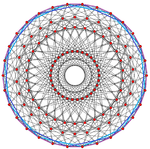Boerdijk–Coxeter helix
 
|
| CCW and CW turning |
 Edges can be colored into 6 groups, 3 main helixes (cyan), with the concave edges forming a slow forward helix (magenta), and two backwards helixes (yellow and orange)[1] |

The Boerdijk–Coxeter helix, named after
Buckminster Fuller named it a tetrahelix and considered them with regular and irregular tetrahedral elements.[3]
Geometry
The coordinates of vertices of Boerdijk–Coxeter helix composed of tetrahedrons with unit edge length can be written in the form
where , , and is an arbitrary integer. The two different values of correspond to two chiral forms. All vertices are located on the cylinder with radius along z-axis. Given how the tetrahedra alternate, this gives an apparent twist of every two tetrahedra. There is another inscribed cylinder with radius inside the helix.[4]
Higher-dimensional geometry

The 600-cell partitions into 20 rings of 30 tetrahedra, each a Boerdijk–Coxeter helix.[5] When superimposed onto the 3-sphere curvature it becomes periodic, with a period of ten vertices, encompassing all 30 cells. The collective of such helices in the 600-cell represent a discrete Hopf fibration.[6] While in 3 dimensions the edges are helices, in the imposed 3-sphere topology they are geodesics and have no torsion. They spiral around each other naturally due to the Hopf fibration.[7] The collective of edges forms another discrete Hopf fibration of 12 rings with 10 vertices each. These correspond to rings of 10 dodecahedrons in the dual 120-cell.
In addition, the 16-cell partitions into two 8-tetrahedron rings, four edges long, and the 5-cell partitions into a single degenerate 5-tetrahedron ring.
| 4-polytope | Rings | Tetrahedra/ring | Cycle lengths | Net | Projection |
|---|---|---|---|---|---|
| 600-cell | 20 | 30 | 30, 103, 152 |  |

|
| 16-cell | 2 | 8 | 8, 8, 42 | 
| |
| 5-cell | 1 | 5 | (5, 5), 5 | 
| |
Related polyhedral helixes
Equilateral square pyramids can also be chained together as a helix, with two vertex configurations, 3.4.3.4 and 3.3.4.3.3.4. This helix exists as finite ring of 30 pyramids in a 4-dimensional polytope.
And equilateral pentagonal pyramids can be chained with 3 vertex configurations, 3.3.5, 3.5.3.5, and 3.3.3.5.3.3.5:
In architecture
The Art Tower Mito is based on a Boerdijk–Coxeter helix.
See also
- Clifford parallel cell rings
- Toroidal polyhedron
- Line group#Helical symmetry
- Skew apeirogon#Helical apeirogons in 3-dimensions
Notes
- ^ Sadoc & Rivier 1999, p. 314, §4.2.2 The Boerdijk-Coxeter helix and the PPII helix; the helix of tetrahedra occurs in a left- or right-spiraling form, but each form contains both left- and right-spiraling helices of linked edges.
- ^ Sadler et al. 2013.
- ^ Fuller 1975, 930.00 Tetrahelix.
- ^ "Tetrahelix Data".
- ^ Sadoc 2001, pp. 577–578, §2.5 The 30/11 symmetry: an example of other kind of symmetries.
- ^ Banchoff 2013, studied the decomposition of regular 4-polytopes into honeycombs of tori tiling the Clifford torus which correspond to Hopf fibrations.
- ^ Banchoff 1988.
References
- ISBN 052120125X.
- Boerdijk, A.H. (1952). "Some remarks concerning close-packing of equal spheres". Philips Res. Rep. 7: 303–313.
- Fuller, R.Buckminster (1975). Applewhite, E.J. (ed.). Synergetics. Macmillan.
- Pugh, Anthony (1976). "5. Joining polyhedra §5.36 Tetrahelix". Polyhedra: A visual approach. University of California Press. p. 53. ISBN 978-0-520-03056-5.
- Sadler, Garrett; Fang, Fang; Kovacs, Julio; Klee, Irwin (2013). "Periodic modification of the Boerdijk-Coxeter helix (tetrahelix)". arXiv:1302.1174v1 [math.MG].
- Lord, E.A.; Ranganathan, S. (2004). "The γ-brass structure and the Boerdijk–Coxeter helix" (PDF). Journal of Non-Crystalline Solids. 334–335: 123–5. .
- Zhu, Yihan; He, Jiating; Shang, Cheng; Miao, Xiaohe; Huang, Jianfeng; Liu, Zhipan; Chen, Hongyu; Han, Yu (2014). "Chiral Gold Nanowires with Boerdijk–Coxeter–Bernal Structure". J. Am. Chem. Soc. 136 (36): 12746–52. PMID 25126894.
- Lord, Eric A.; Mackay, Alan L.; Ranganathan, S. (2006). "§4.5 The Boerdijk–Coxeter helix". New Geometries for New Materials. Cambridge University Press. p. 64. ISBN 978-0-521-86104-5.
- Banchoff, Thomas F. (1988). "Geometry of the Hopf Mapping and Pinkall's Tori of Given Conformal Type". In Tangora, Martin (ed.). Computers in Algebra. New York and Basel: Marcel Dekker. pp. 57–62.
- Banchoff, Thomas F. (2013). "Torus Decompostions of Regular Polytopes in 4-space". In Senechal, Marjorie (ed.). Shaping Space. Springer New York. pp. 257–266. ISBN 978-0-387-92713-8.
- Sadoc, J.F.; Rivier, N. (1999). "Boerdijk-Coxeter helix and biological helices". The European Physical Journal B. 12 (2): 309–318. S2CID 92684626.
- Sadoc, Jean-Francois (2001). "Helices and helix packings derived from the {3,3,5} polytope". S2CID 121229939.












